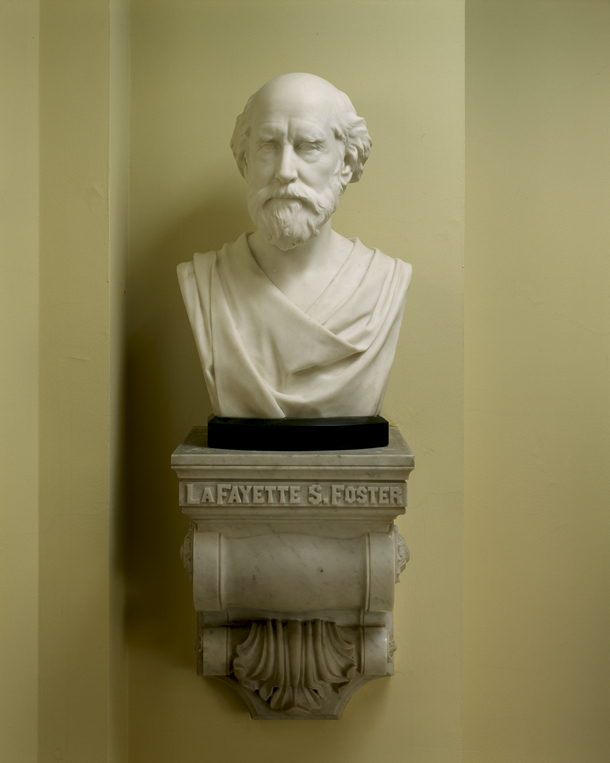
| Title | Lafayette Foster |
| Artist/Maker | Charles Calverley ( 1833 - 1914 ) |
| Date | 1879 |
| Medium | Marble |
| Dimensions | h. 22 x w. 15.5 x d. 12.25 in. (h. 55.9 x w. 39.4 x d. 31.1 cm) |
| Credit Line | U.S. Senate Collection |
| Accession Number | 21.00006.000 |
Lafayette Foster’s widow presented this marble likeness of her husband to the U.S. Senate in 1885. Sculptor Charles Calverley of Albany, New York, created the bust several years before Foster’s death. Foster may have commissioned the work with the intention of presenting it to the Senate to commemorate his service as acting vice president.
Although Charles Calverley was 45 years old when he carved the bust, it was nonetheless an early work. Calverley began his career as an independent sculptor at the age of 35. He apprenticed for seven years in “a one horse marble shop” in Albany, New York, before becoming an assistant to the noted sculptor Erastus Dow Palmer. [1] Fifteen years later, in 1868, Calverley moved to New York City. There he established himself almost exclusively as a carver of marble portrait medallions and busts. Even though Calverley produced more than 250 works during his lifetime, it is difficult to form a balanced assessment of his style and achievement. Most of the portraits familiar from the scattering of published reproductions are naturalistic and, in works after 1890, rather prosaic.
The bust of Lafayette Foster, however, is a notable exception. Calverley’s choice of the neoclassical style is remarkable so late in the century, but much more remarkable is his success in it. Not just Greco-Roman in type but also in spirit, this Foster is like a bust of Homer or Seneca. (In fact, it can profitably be compared with the Homer--a Roman copy of a Greek head–-in the Museum of Fine Arts in Boston.)
The bust convincingly projects probity and dignity, and is severe in the best sense. The head, large in comparison with the torso, is presented frontally, but a slight turn eases the severity. The eyes are lightly drilled, balancing animation with sobriety. The firm mouth appears clearly through the buttery modeling of beard and moustache. The torso is conceived like a classical herm (armless, quadrangular, and tapered downward), but it is adorned with a light, subtly carved drapery in the classical manner. Throughout, Calverley combines suppleness of modeling with distinct linear accents to infuse unexpected life into the unfashionable neoclassical style. This is an especially memorable likeness of Foster, embodying the description by writer Mary Clemmer Ames of “Foster of Connecticut, that most gentle gentleman, who went from the Senate bearing the good will of every Senator whatever his politics.” [2]
The bust was not officially commissioned by the Senate, but was formally accepted by Senate resolution dated February 19, 1885. Temporarily displayed in the Senate Chamber adjacent to the presiding officer’s chair, it was later permanently mounted on a marble, wall-hung pedestal for display in the Vice President’s Room of the Capitol.
Calverley worked increasingly in bronze from the 1880s on. He portrayed in bronze one of his most important subjects–-the poet Robert Burns–-in full-length, bust, and medallion form. The full-length, nine-foot seated statue of Burns was unveiled in Albany’s Washington Park in 1888. The bronze bust of the poet is in the Metropolitan Museum of Art in New York City, a gift of Andrew Carnegie. The majority of Charles Calverley’s works have not been identified; the Albany Institute of History and Art owns the largest collection of his sculptures.
1. Albert TenEyck Gardner, American Sculpture: A Catalogue of the Collection of the Metropolitan Museum of Art (New York: Metropolitan Museum of Art, 1965), 34.
2. Mary Clemmer Ames, Ten Years in Washington: Life and Scenes in the National Capital, as a Woman Sees Them (Hartford, CT: A.D. Worthington, 1873), 96.
Connecticut Senator Lafayette Sabine Foster served as president pro tempore of the Senate from 1865 to 1867. Because of his position, Foster served as acting vice president upon the death of President Abraham Lincoln and the swearing in of Vice President Andrew Johnson as president. Foster also received the vice president's salary.
Born in Franklin, Connecticut, Foster studied law and established a legal practice in Norwich, Connecticut, where he became editor of the Whig newspaper, the Norwich Republican. Prominent in the Connecticut legislature, he served three years as Speaker of the state house of representatives. In 1854 he was elected to the U.S. Senate as a Republican; he served for 12 years. Following an unsuccessful reelection bid, Foster became professor of law at Yale College before returning to the state legislature, where he was elected Speaker. Foster subsequently resigned to become associate justice of the Connecticut Supreme Court, where he served from 1870 to 1876. During his judicial service, Foster ran unsuccessfully as a Democratic candidate for Congress. He resumed his law practice after retiring his seat on the state supreme court. He died in Norwich in 1880.